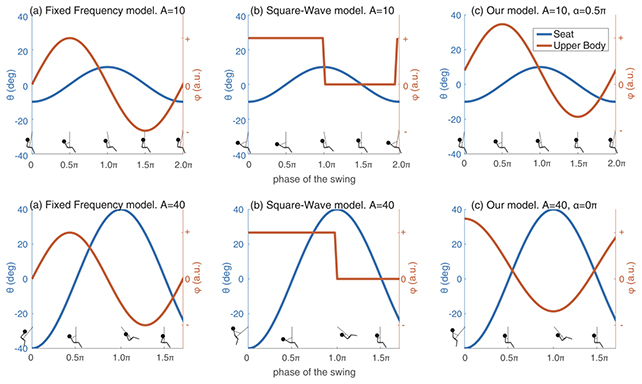The sense of how to shift our position on a playground swing tends to come naturally as part of growing up – a bit like learning how to ride a bike – and now scientists have put together a mathematical model for the ultimate swinging technique.
In particular, the model identifies how riders adapt how they 'pump' the swing as the swinging distance increases. Until now, the perfect swinging technique hasn't been put down in scientific form.
Here's how to swing perfectly, as determined by a new study by researchers from Japan and Australia: When you're just starting with the swinging, lean all the way back on the forward swing just as it passes its equilibrium point (with the swing chains pointing straight down).
As the swinging motion builds momentum, you need to start leaning back earlier – ideally at the highest point on the backward swing, just before you start going forward again. It's this change that maximizes the oscillations of the swing.
"To build our model of the dynamics of pumping the playground swing, we combined and expanded upon the key aspects of two models that have been proposed to capture how the upper body moves to pump a swing," write the researchers in their published paper.
The first type of model the researchers looked at was the older fixed-frequency model (FFM), where riders rock backward and forward at a fixed frequency, creating a sort of sine wave with their bodies. It's fine at the start, but it doesn't really work as the swinging distance starts to increase.
A newer square-wave model (SWM) was also considered. This proposes that people shift their weight automatically based distance of each swinging motion and their point in it, but there are issues with this model. Specifically, it suggests a jarring, unnatural adjustment in position, whereas, in reality, it's a smooth and seamless one.

The research wasn't all theoretical: The team used 10 college-age students in the lab to examine how they operated a swing. They were asked to pump the swing as they would naturally, without touching the floor, and at three different swing chain lengths.
"The chain length of a swing is one of the key parameters that determines the resonant frequency of the swing," write the researchers.
"The motion data of participants swinging for three different chain lengths were therefore examined to verify the reliability of our model and the role of the initial phase on pumping a swing."
Sure enough, motion capture data revealed that study participants were indeed pumping the swing as predicted by the new and improved mathematical model, a combination of the FFM and the SWM.
The new model also accounted for subtle changes in positioning and movement depending on the goal of the rider: to either increase the amplitude of the swing or to maintain the current amplitude when the swing is at its maximum.
Some questions remain for future research, including how this all comes so naturally to us. One idea proposed by the researchers is that our subconscious sensing of centrifugal forces enables us to make small but significant movements on the swing.
"The current paper demonstrates the importance of frequency and initial phase modulations in pumping a playground swing, and in contrast to previous work, provides a more ecologically valid model and understanding of the dynamics of playground swinging," write the researchers.
The research has been published in Physical Review E.
